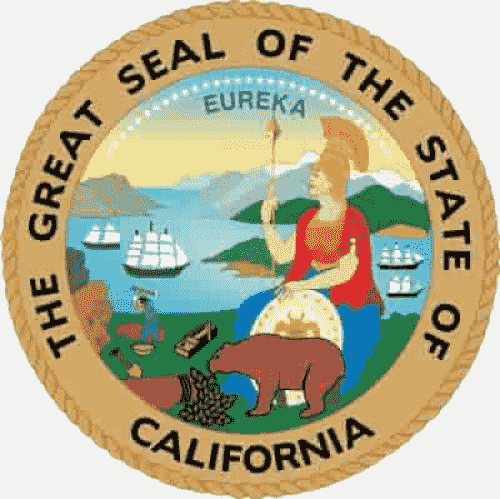 State Flag |  State Seal |
California is a state located on the West Coast of the United States. It is the most populous U.S. state, home to one out of eight people who live in the U.S., with a total of 38 million people, and it is the third largest state by area.
- ABBREVIATION: CA
- NICKNAME: The Golden State
- POPULATION: 39,431,263 (2024 est.)
- CAPITAL: Sacramento
- STATE BIRD: California Valley Quail
- STATE FLOWER: Golden Poppy
- AREA: 163,696 sq. mi.
- TIME ZONE: Pacific Time Zone with DST
- ENTERED UNION: Sept. 9, 1850
- ALTITUDE: High 14,505 ft. Mount Whitney
- CLIMATE: Mostly rainless summers throughout. Cool foggy summers, mild winters on the coast. Hot summers inland. Winter snows in the high mountains.
From the fire-clad Klamath Mountains at its northern borders to the scorching Mojave Desert in the south, California is a land of contrasts. In Mount Whitney it boasts the highest point of land in the United States except for Alaska; in Death Valley, only 90 miles away, the lowest.
California’s irrigated Central Valley, bounded by four major mountain ranges, is the nations leading producer of fruits and vegetables. The valley drains west into the great bay of San Francisco, finance and distribution center of the Pacific Coast.
To the south lie the highly urbanized Los Angeles basin, renowned for its diverse activities-ranging from oil processing and aircraft manufacturing to orange-growing, television and movie making.

Big Sur at The Pacific Coast, California
In 1849, lured by the widely heralded discovery of gold in the creek at Sutter’s Mill, nearly 40,000 would-be prospectors and their followers poured pell-mell into California. Today a seemingly endless tide of migrants travel to the west coast for the golden sunshine, and for opportunities to follow their personal dream.
Fun Facts:
- More Native Americans live in California than in any other U.S. state.
- California grows more than half the nation’s fruits, nuts, and vegetables; in addition, it produces more milk than the state of Wisconsin.
- Lake Tahoe has enough water to flood California to a depth of 14 inches.
- California has the highest and the lowest points in the lower 48 states: Mount Whitney at 14,494 feet, and Death Valley at 282 feet below sea level.
- The world’s largest solar power plant is located near San Luis Obispo. Known as The Topaz project, or Topaz Solar Farm, it is now in full operation with a capacity of 550 MW capacity (2015 est.).
- California contains the tallest, biggest, and oldest trees in the world: a 368-foot-tall coast redwood, a giant sequoia measuring 275 feet high by 103 feet around, and a 4,700 year-old bristlecone pine.
History:
California’s history is a remarkable journey of cultural diversity, exploration, innovation, and transformation. Long before European explorers arrived, the land was home to over 100 Native American tribes, including the Chumash, Miwok, Yurok, and Tongva. These groups had well-developed societies, languages, and spiritual traditions, living off the rich resources of the coast, forests, and valleys.
In 1542, Portuguese explorer Juan Rodríguez Cabrillo, sailing under the Spanish flag, became the first European to explore the California coast. However, it wasn’t until 1769 that the Spanish began to establish missions in the region, starting with Mission San Diego de Alcalá. Led by Father Junípero Serra, the mission system aimed to convert Indigenous peoples to Christianity and Spanish customs. Over the next five decades, 21 missions were founded along what became known as El Camino Real.
After gaining independence from Spain in 1821, Mexico took control of California. The mission lands were secularized, and large ranchos were granted to Mexican citizens, creating a ranching economy. However, this era was short-lived.
In 1846, during the Mexican-American War, American settlers staged the Bear Flag Revolt and declared California an independent republic. Shortly after, U.S. forces took control, and California was ceded to the United States in the 1848 Treaty of Guadalupe Hidalgo.
That same year, gold was discovered at Sutter’s Mill, sparking the California Gold Rush of 1849. Thousands of people from around the world flooded into the region in search of fortune, transforming sleepy settlements into booming towns overnight. San Francisco, in particular, grew rapidly from a small village to a major city. The population surge and economic growth led to California’s swift admission as the 31st state on September 9, 1850.
The second half of the 19th century saw further expansion, with the completion of the Transcontinental Railroad in 1869 linking California to the rest of the U.S. Agriculture became a cornerstone of the economy, with irrigation turning the Central Valley into one of the most productive farming regions in the world.
In the 20th century, California became a hub of innovation and culture. The rise of Hollywood made the state the center of the entertainment industry, while World War II brought defense manufacturing and military bases. After the war, California experienced massive population growth, suburban expansion, and economic diversification.
The state also played a central role in major social and political movements, from the environmental and labor movements to the Free Speech Movement at UC Berkeley and the fight for LGBTQ+ rights in San Francisco. In recent decades, Silicon Valley has positioned California as a global leader in technology and innovation.
Today, California is the most populous U.S. state and the world’s fifth-largest economy. It remains a place of opportunity, cultural richness, and dynamic change. From its Native American roots and Spanish missions to the Gold Rush and modern tech boom, California’s history is a story of constant reinvention and bold ambition.